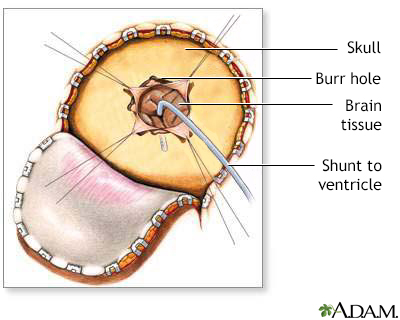Craniotomy for cerebral shunt

During a cerebral shunt procedure a flap is cut in the scalp and a small hole is drilled in the skull. A small catheter is passed into a ventricle of the brain. A pump (valve which controls flow of fluid) is attached to the catheter to keep the fluid away from the brain. The accumulation of excess fluid around the brain can cause an increase in intracranial pressure. The excess pressure can cause a decrease in blood flow to the brain leading to brain damage.

|
Review Date:
12/31/2023 Reviewed By: Joseph V. Campellone, MD, Department of Neurology, Cooper Medical School at Rowan University, Camden, NJ. Review provided by VeriMed Healthcare Network. Also reviewed by David C. Dugdale, MD, Medical Director, Brenda Conaway, Editorial Director, and the A.D.A.M. Editorial team. |
The information provided herein should not be used during any medical emergency or for the diagnosis or treatment of any medical condition. A licensed medical professional should be consulted for diagnosis and treatment of any and all medical conditions. Links to other sites are provided for information only -- they do not constitute endorsements of those other sites. No warranty of any kind, either expressed or implied, is made as to the accuracy, reliability, timeliness, or correctness of any translations made by a third-party service of the information provided herein into any other language. � 1997-
A.D.A.M., a business unit of Ebix, Inc. Any duplication or distribution of the information contained herein is strictly prohibited.
